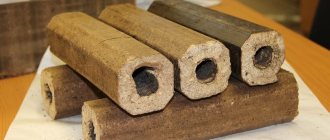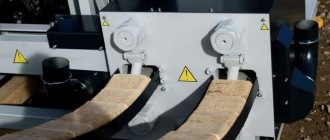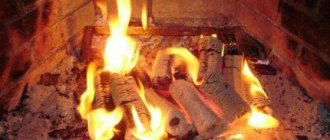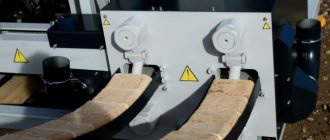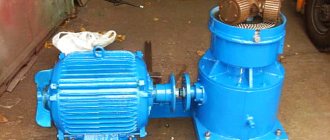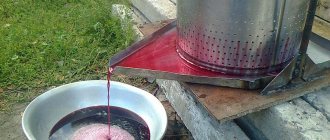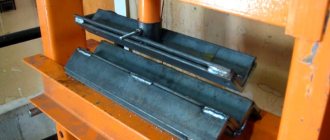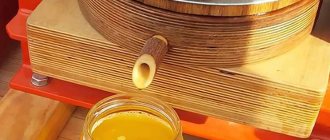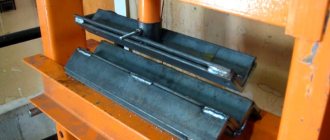Here you will learn:
- Types of briquetting machines
- Design features of the pressing apparatus
- Manufacturing based on other devices
- Press for making fuel briquettes with your own hands
- The simplest design of a homemade press
- Available methods of creating pressure
At home, the production of briquettes from sawdust is carried out using the same technologies as in the conditions of a production enterprise, therefore, before starting to create home-made equipment to solve this problem, it is necessary to delve into all the technological nuances of the production of this fuel.
Technological scheme for the production of fuel briquettes in industrial conditions
The process of producing briquettes for heating begins with grinding the feedstock, which, as mentioned above, can be sawdust, shavings, as well as agricultural waste: husks of wheat, buckwheat, rice and sunflower husks. After grinding, the raw materials for fuel briquettes are thoroughly dried to a moisture level of about 10%.
The formation of a dense briquette from the initial raw material can be carried out according to one of two technological schemes. To implement each of them, appropriate equipment is required, namely:
- briquetting press;
- press extruder.
Hydraulic press for the production of fuel briquettes without the use of binders
The technology for making briquettes for heating, both in the first and second cases, involves exerting significant pressure on the raw material, as a result of which lignin, a natural component that acts as a binder, begins to be released from the wood. Thus, for the production of briquettes there is no need to use additional adhesives, which allows you to maintain the environmental purity of the fuel.
To produce Euro firewood according to the first technological scheme, a mechanical or hydraulic briquette press is used, capable of generating a force of up to 500 Bar. As a result of such force action, spontaneous heating of the raw materials used occurs and the formation of a dense rectangular bar from it.
The extrusion scheme for the production of fuel briquettes involves the use of a screw press, which is capable of exerting pressure on the raw materials used, the value of which reaches 800–1000 Bar.
Diagram of the extruder press operation
When implementing this technology for the production of Euro-firewood, the raw materials are loaded into a receiving hopper, which is equipped with a screw briquetting machine. Next, the raw material captured by the screw is pushed into the narrowed channel of the press, where the material is compacted under high pressure. When compressed in the narrowed part of the working chamber of a sawdust screw press, spontaneous heating of the raw material occurs, as a result of which the finished briquette is formed under simultaneous exposure to high pressure and significant temperature. The finished briquette, when pressed on auger equipment, has the form of a hexagonal block, cut into pieces of the required length.
This is how briquettes are squeezed out by an auger
Types of briquetting machines
When thinking about which press for making briquettes will be the best for working at home, it doesn’t hurt to familiarize yourself with the design and operating features of today’s most popular models of installations so that you can choose the best option. This list includes:
- A hydraulic machine, which is the most budget and affordable of all existing presses. The low price of such equipment is due to the fact that the fuel packages produced with its help are too loose and often disintegrate into small fractions during the combustion process, not producing strong and lasting heat.
- Screw press for sawdust. Making a structure of this type with your own hands is not so easy, since it has a fairly high level of complexity in manufacturing and involves the use of certain elements such as a screw, which resembles a steel spiral rod in conventional meat grinders. Nevertheless, all the efforts made will certainly be worth it, since briquettes made on screw-type installations have a high density and the ability to burn for a long time.
- A mechanical impact press is one of the most common types of design for homemade briquette production, as it is not too difficult to manufacture. As for the finished product, the output is something between fuel packages made on a hydraulic and auger installation.
- Press granulator, which is used for processing animal feed. Such a machine is also perfect for pressing fuel raw materials, but on the condition that only its fine fraction will be processed.
When organizing a home production of briquettes for heating, you should take into account its potential power, the volume and characteristics of the available materials that will be processed by the press, as well as the availability of available tools for constructing a home-made installation. A detailed study of the pros and cons of different types of installations will also help you make the right decision.
Advantages and disadvantages of models
Most often, households and small production shops use hydraulic presses, which can operate from an individual or a common (group) drive. As a rule, such devices have the following advantages and disadvantages:
- Almost any construction waste can be used for processing in a hydraulic press, including wood, wood shavings and sawdust, plywood residues, dry leaves, etc.
- Compared with other processing units, the hydraulic press has the lowest noise level during operation.
- The high strength and reliability of the design contributes to the most accurate supply of raw materials and almost instantaneous processing, despite the fact that some units boast the presence of a speed regulator.
- The only drawback of such equipment is the low density of the briquettes produced.
That is, a hydraulic press is more suitable for those people who are simultaneously involved in the woodworking industry and do not suffer from a lack of raw materials. If there is not so much material for making fuel briquettes, then it is better to take a closer look at any other design that will allow you to produce denser briquettes that can burn for a long time and well.
An alternative to a hydraulic press can be a screw installation, which not only crushes the material into dust, drying it at the same time, but also ensures its maximum density at the outlet due to the strong pressure created inside the unit. It is worth highlighting the following pros and cons of the screw machine:
- The device boasts the highest efficiency compared to any other analogues.
- Processing raw materials in screw installations allows us to obtain the highest quality briquettes of an ideal shape with a characteristic cavity inside, which perfectly withstand transportation over long distances and do not crumble during the combustion process.
- One of the disadvantages of such a press is the need to maintain certain operating conditions to ensure a full-fledged work process. For example, a drop in the internal temperature inside a unit can quickly stop a production cycle.
- The cost of such equipment is usually very high, so many owners have to look at more budget-friendly and less productive units.
Making a screw machine will only be possible for experienced craftsmen who know how to use a lathe. In addition, to construct this complex device you will need only the strongest and highest quality steel.
The best option may be an impact mechanical machine, which, in addition to sawdust, is capable of processing straw, stone and wood, coal dust, dried flowers and any other raw materials of various shapes and sizes. The productivity of such equipment significantly exceeds those demonstrated by a hydraulic press, but is inferior to a screw machine.
In this case, the processing process can be automated as much as possible and not be given as much attention as servicing a screw-type unit requires. At the same time, the cost of such machines is too high, so many craftsmen make such structures on their own. As for granulators, they are most often used for processing the smallest raw materials, although some craftsmen use similar installations for double processing, first crushing the raw materials and only then proceeding to compact them into fuel packages.
Advantages of pellets over other types of solid fuel
The wide distribution of fuel briquettes, which are also called eurowood and pellets, is due to a whole list of their advantages:
- compact size, which ensures ease of storage and transportation;
- emitting a small amount of smoke and minimal sparking during combustion;
- long burning period (when compared with ordinary firewood, pressed sawdust fuel burns at least twice as long);
- environmentally friendly (compressed from waste materials of natural origin, fuel briquettes do not emit substances harmful to humans and the environment when burned);
- low ash content (the amount of ash formed after complete combustion of pellets does not on average exceed 1% of the total mass of fuel used).
The main advantages of fuel briquettes are long burning and minimum ash
Design features of the pressing apparatus
A homemade briquette press is a mechanical unit. Its key elements:
- Work table-bed. All structural parts of the press will be fixed on this basis.
- Support frame. Regulates and directs the force that a person exerts on the press.
- Drive unit. Can be manual or mechanical (hydraulic or electric motor).
- Punch. This is a drive element that has a direct impact on the bulk raw material.
- Forming container. Must have perforations.
The simplest press is equipped with a screw manual drive. Pressure is applied to the workpiece by tightening the screw. Its productivity is quite low, so this press has not gained wide popularity among the people. Time and energy are wasted on loading and unloading and tightening the screw. A briquette press with a long lever and the function of independently squeezing the finished brick outward looks comparatively more advanced. Such a machine can be improved by complicating the design with a hydraulic jack.
Advice. To speed up the pressing process, a second matrix mold is welded onto the work table.
Manufacturing based on other devices
If there is no desire to create a press for making briquettes from scratch, then you can try to rework some other device for such a mechanism. This can be a jack or a small hydraulic press, which is additionally equipped with a punch and a die.
It is important to understand that all home-made installations are not capable of providing the pressure at which lignin production occurs. As a result, a number of third-party additives are added to the original mass, including:
- inexpensive adhesive (for example, for wallpaper);
- clay (for 1 part of raw materials take 10 parts of waste);
- soggy paper or corrugated cardboard.
When producing a machine for briquettes, it is important to take into account such a stage as grinding raw materials. Manual cutting of the material is not recommended, since such manipulation takes a lot of time and effort. Instead, it is recommended to use additional devices, for example, a shredder from an old activator washing machine, into which knives are placed. You can also buy a rotary machine. Its task is to grind plant components.
Another important point is the grinding of raw materials; manual cutting of the material is not recommended, since such manipulation takes a lot of time and effort.
To successfully manufacture a lever or screw press, you do not need to purchase additional parts. However, such devices do not have special operating properties. A press made from a hydraulic jack, on which an electric or manual drive is installed, will be more effective.
A punch is added to the finished equipment, the dimensions of which are comparable to the dimensions of the matrix where the pressing takes place. To create the matrix, take a thick-walled pipe in which holes are made for the ventilation system. The matrix is additionally equipped with a removable bottom - it can be removed after receiving the finished briquette.
Step by step: how to make briquettes at home
If your goal is not hard work with a good profit, but needs related to heating only your home, purchasing equipment is not very practical. The units cost from 300 thousand to a million, that is, they will not pay off soon. The press can be made manually, by yourself, of your own production. And here there are two options for the development of events - to make a press from scratch, or to use a ready-made existing mechanism.
In addition to components of plant origin - wood waste and husks of various agricultural crops - coal dust can be used to make briquettes
So let's say you're making abs from scratch. To create a force suitable for compressing raw materials, a lever or screw mechanism is needed. A lever press can even be made of wood, but a screw press will require steel blanks and a lathe.
Of course, it is easier to work with a ready-made mechanism. For example, suppose you have a jack or a hydraulic press. This device must be supplemented with a matrix and a punch. But no matter how cool the press you make with your own hands, it will not be able to achieve the effort required to produce lingin. Therefore, binders will have to be added to the raw materials. The easiest option is cheap wallpaper glue.
You can also add clay in proportions of 1:10; some types of soaked paper are also used. For example, corrugated cardboard - it already contains lingin, and in contact with moisture its fastening properties appear. Interestingly, if we are talking about making briquettes at home, then the material is not dried, but soaked in water for better gluing of the particles. And the finished briquette is dried in the fresh air.
Read also: What is the designation of microfarad on a capacitor
Press for making fuel briquettes with your own hands
The purchase of ready-made equipment for the production of briquettes, depending on its capacity, will cost from 300 thousand to 1 million rubles.
Of course, for a private owner who wants to start producing this fuel purely for his own needs, such costs are impractical, since they will not pay off soon. It would be more correct to make a press from scrap materials, especially since there is nothing complicated in its design.
You can build the necessary equipment from scratch or use ready-made mechanisms.
Homemade machine
Scheme
Homemade lever and screw presses do not require the use of purchased products, but they cannot boast of significant compression force. It is proposed to assemble a press based on a hydraulic jack or the same press.
It can be equipped with an electric motor or a manual drive:
- We will attach the punch to the hydraulic installation. Its dimensions must correspond to the dimensions of the matrix in which the raw materials will be compressed into a briquette.
- We will make the matrix itself from a thick-walled pipe - this is the simplest option. Holes will be made in its walls to allow air and moisture to escape.
- We will equip the matrix with a removable bottom. Having removed it, the finished briquette can be pushed out with a punch into the receiving tray.
Drawing diagram for the production of briquettes from soaked paper pulp
The working mechanism is placed in a housing equipped with two handles for easy transportation.
Necessary materials
In addition to the hydraulic installation, you will need some types of rolled steel:
- Channel.
- Equal angle corner 100x100 mm.
- Sheet thickness 3 – 6 mm. A punch will be cut from it. The thickness of the workpiece depends on the diameter of the matrix: the larger it is, the thicker the punch should be.
From the same sheet we will cut out a removable bottom for the matrix.
- A pipe with a diameter of 25 - 30 mm - the punch rod will be made from it.
- A thick-walled pipe is a blank for the matrix. The diameter depends on what size briquettes the user wants to receive. The thinner they are, the higher their density, but the productivity of the machine will decrease.
- A large diameter pipe is a blank for the mixer body. If there is no suitable pipe, the drum can be made from a sheet of tin.
- Galvanized steel for the manufacture of trays.
In total, you will need two trays - for loading the prepared material into the matrix and for receiving the finished briquettes.
Manufacturing and assembly instructions
The order of operations in the manufacture of the press looks like this:
- It is necessary to weld the base of the device from the channels.
- From the corner we make 4 racks 1.5 meters long. They are welded vertically and with the same pitch.
- Next, you need to make a drum from a pipe or sheet of tin in which the raw materials will be mixed. If you have a broken washing machine, the drum, as well as the bearings, can be removed from it.
- The drum must be attached to the stands. If possible, it should be equipped with an electric motor. If the motor is too high-speed and it is not possible to reduce the rotation speed of the drum to an acceptable value due to the difference in pulley diameters alone, a gearbox should be used.
- It is necessary to attach a tray under the drum through which the prepared material will be fed into the matrix.
- In the walls of the pipe used as a blank for the matrix, it is necessary to make several holes with a diameter of 3 - 5 mm. They must be distributed evenly so that air and water are squeezed out throughout the entire volume of the briquette.
- A flange must be welded to the bottom of the matrix, to which the removable bottom will be screwed. This bottom is cut from a steel sheet in the form of a disk with eyes.
- The matrix is welded or screwed to the base under the loading tray.
- We cut out a round punch from a steel sheet. This is simply a disk whose diameter allows it to freely enter the matrix.
The rod is made of a pipe: a diameter of 30 mm is sufficient. One side of it is welded to the punch, and the other is attached to the hydraulic unit.
Next, the entire assembly should be attached to the racks exactly above the matrix.
We fix the receiving tray under the matrix. It is important to install it in such a position that it does not interfere with removing and installing the removable bottom of the matrix.
To reduce the time spent on removing the finished briquette from the matrix, and thereby make the machine more productive, a spring with a disk of the same diameter as the punch can be welded to the bottom of the matrix.
After turning off the hydraulic unit and removing the punch, the product will be pushed out automatically by the spring.
The economic side of the coin
To produce 1 ton of fuel briquettes you need to take approximately 2 tons of wood waste or 1.5 tons of straw. At the same time, the electricity consumption is approximately 100 kWh/t.
The calorific value of this heating product is 19 MJ/kg, which is much higher than that of conventional firewood (only 10 MJ/kg).
With the right choice of equipment, manufacturing and storage of products, the technology pays for itself in about 2 years.
After reading my article, you can decide for yourself what is better: make heating material from unnecessary raw materials, save time and money, or continue heating with wood. After all, when using briquettes, you can dispose of waste that is unnecessary in everyday life, and heat your dacha or bathhouse with environmentally friendly fuel briquettes. If you want to organize your own pellet production, then you will simply need information about organizing the technological chain, and my new book “Typical mistakes of equipment manufacturers when planning pellet production” will help you with this.
The simplest design of a homemade press
There are several simple ways to make a briquette press with your own hands, using available mechanisms and available materials. So, a novice master can adopt the following principles:
- The most primitive design of a homemade press is based on a 10-centimeter equilateral steel angle and a punch made of a stainless steel sheet with a cross-section of 3-6 mm. In this case, the sheet blank must be provided with a special removable bottom, the diameter of which will exactly correspond to the diameter of the finished product.
- If you want to increase the productivity of the installation, then you should think about equipping it with an electric motor, which can be supplemented with a gearbox necessary to reduce the speed of the motor. The last measure is necessary in order to avoid overheating of the unit.
- As materials required for the manufacture of working units of the general mechanism (rod, matrix, etc.), it is best to use a steel pipe with a cross section of 2.5-3 cm, as well as thick-walled elements with a diameter corresponding to the diameter of the briquette packages at the outlet.
- During the assembly process, 4 identical racks are made from a metal corner, which are installed at the same distance from each other. A drum is cut out of sheet steel and welded, intended for rotating and mixing raw materials, which can be safely replaced with an element borrowed from a failed washing machine. A tray is installed between the drum and the matrix, while the removable bottom of the last element is fixed using flanges. The bottom itself looks like a sheet stainless steel disk with eyes.
- It is also recommended to make the punch from stainless steel, giving it a round shape (the diameter of this important component must correspond to the diameter of the matrix). The punch must be connected to the hydraulic unit by a rod, which is made from a pipe with a 3-centimeter diameter.
It should be noted that a homemade machine for making briquettes from sawdust is not capable of producing during the pressing process the substance necessary for binding small particles, which is called lignin. That is why it is recommended to add a substitute to sawdust in the form of ordinary wallpaper glue, pre-soaked corrugated cardboard and river clay (1 part gluten per 10 parts dry raw materials).
Benefits of sawdust logs
The following arguments can be given in favor of briquettes pressed from sawdust:
- Long burning time - 4 hours.
- Minimal smoke generation.
- Environmentally friendly. The starting materials are natural materials, so you can fertilize the beds with ash.
- High energy output. It far exceeds the energy capabilities of firewood and is comparable only to high-quality coal.
- Constant combustion temperature.
- Economical. The cost of 1 ton of such fuel will be cheaper than the corresponding amount of firewood or coal.
- Possibility of self-production.
There are also disadvantages. The main one is the fear of moisture. They cannot be stored in the open air, because... they will quickly absorb moisture and therefore will burn poorly. Therefore, it is necessary to allocate a dry room for storage.
Any significant mechanical impact on sawdust briquettes is contraindicated. If you buy special equipment for their production, the cost will be high and not always justified.
Replacing coal and firewood with sawdust briquettes makes heating a country home more environmentally friendly. While heating with wet wood leads to the release of harmful substances, “Eurowood” is completely safe in this regard
It is profitable to set up handicraft production if the sawdust is free, and you can use existing equipment for installation.
Available methods of creating pressure
There are three common ways to achieve pressure that are well suited for a homemade fuel briquette press: using a lever, a hydraulic jack or a screw. Each of them is good in its own way, and their implementation in practice is not very difficult.
Use of muscular strength and leverage
Usually a metal pipe is used as a lever. It should not bend under the influence of human muscular strength. For example, a reinforced water pipe with a diameter of 40 or 50 mm with a wall thickness of 4 - 4.5 mm is suitable.
Formula for calculating the piston pressure force (m) depending on the force applied by a person (M), the distance from the piston to the lever attachment point (l) and its total length (L)
The length of the lever and the distance from the fulcrum to the connection with the piston are chosen not only based on achieving the desired pressure. Another important parameter is the depth of immersion of the piston into the glass (h, cm).
It is calculated using the formula:
h = R * (l / L)
Here R (cm) is the height to which the end of the lever will fall.
It is advisable to make the structure in such a way that the depth of immersion of the piston is sufficient to form a briquette without repeated compression with preliminary addition of material. This will greatly increase the production rate.
The required immersion depth of the piston (h, cm) can be calculated knowing the initial dry (q1) and briquetted (q2) density of the raw material and the height of the glass (H):
h = H * (1 – q1 / q2)
If for some reason an error occurs (usually due to incorrect determination of the initial density of the raw material) and the depth of immersion of the piston is not enough to impart the required hardness to the product, then it is not necessary to digest the entire structure.
You can either reduce the height of the glass, or, adding sawdust, press one briquette in two or three passes.
Application of hydraulic jack
To create strong pressure, hydraulic devices are used, such as the usual bottle jacks. As a rule, in a household where there is a car or other equipment, such hydraulic units are available, but their carrying capacity may be insufficient.
The design of a typical hydraulic press consists of a frame and a movable beam on which a jack is placed. The system returns to its original position due to the action of springs
Jacks are inexpensive. Thus, models designed for 30-40 tons can be purchased for less than 5 thousand rubles. And with such indicators it is already possible to obtain briquettes of large cross-section or several (3-5) copies of regular size at once.
To produce several briquettes at the same time, the required number of molds are placed in a row. The middle moving frame must be strong so that it does not bend over time. It is best made from an I-beam or thick-walled profile pipe.
The pressing process itself takes longer than when using a lever design. However, the use of a powerful hydraulic jack allows one to achieve much greater specific pressure on the workpiece. The briquettes are more even and dense and already have an attractive presentation.
Production scheme
The production of pellets occurs in several stages:
- First, the incoming raw material goes through the first stage of grinding, breaking it into fragments 25*25*2mm. This stage is necessary for more uniform and faster drying. Raw materials are fed into the crushers by a scraper; they should be stored on a concrete floor to prevent the ingress of soil, sand and stones.
- Then the semi-finished product is brought to a moisture content of 8-12% in belt or drum dryers. In all technology, this is the most energy-intensive process, but the quality of the fuel depends on the degree of moisture content of the raw materials. On average, it takes 1 MW of energy to bring 1 ton of raw materials to the required humidity. To reduce costs, bark or other substandard raw materials can be burned in dryers.
- The resulting mass is finely crushed (particles no more than 4 mm, for high-quality granules 1.5 mm) using hammer mills.
- If during the drying process the moisture content of the raw material drops below 10%, the semi-finished product is moistened with finely dispersed water or steam. Steam is necessary for hard wood (oak, etc.) or for stale raw materials. For soft wood or quality raw materials, water is sufficient. Screw mixers are usually used at this stage.
- The resulting product is pressed. The press can have a flat or cylindrical die. The size of the matrix determines the performance of the installation. The amount of raw material produced per unit of time also depends on the diameter of the granules.
- The pellets heated during pressing are cooled. During cooling, their moisture content decreases, which improves quality.
- The granules are sifted and packaged. Sometimes they are stored in bulk in bins, but in order to maintain the quality unchanged, it is advisable to package the products in large bags - big bags, which are delivered to the consumer. The highest quality products are packaged in bags of 20-25 kg.
